Wavefront Sensing by a Common-Path Interferometer for Wavefront Correction in Phase and Amplitude by a Liquid Crystal Spatial Light Modulator Aiming the Exoplanet Direct Imaging
Abstract
1. Introduction
2. Materials and Methods: Common-Path Rotational-Shear Interfero-Coronagraph for Wavefront Measurement
2.1. Common-Path Rotational-Shear Interfero-Coronagraph Principles
2.2. Wavefront Measurement by Means Interfero-Coronagraph and Phase Shifting Interferometry
3. Results
3.1. Numerical Simulation of Wavefront Control in an Optical Scheme with an Interfero-Coronagraph
3.2. Lab Experiment to Verify Wavefront Correction
3.2.1. Schematics of Lab Experiment
3.2.2. Wavefront Correction Maps in Pupil Plane
3.2.3. Coronagraphic PSF Suppression in Focal Plane
3.3. Constraints and Their Overcome
3.3.1. Using an LC SLM for Extreme Wavefront Correction
3.3.2. Using an LC SLM for Wavefront Correction in Phase–Amplitude Mode
4. Discussion
Author Contributions
Funding
Institutional Review Board Statement
Informed Consent Statement
Data Availability Statement
Acknowledgments
Conflicts of Interest
References
- Traub, W.; Oppenheimer, B. Direct imaging of exoplanets. In Exoplanets; Seager, S., Ed.; University of Arizona Press: Tucson, AZ, USA, 2011; pp. 111–156. Available online: https://www.amnh.org/content/download/53052/796511/file/DirectImagingChapter.pdf (accessed on 19 January 2023).
- Guyon, O. Extreme Adaptive Optics. Annu. Rev. Astron. Astrophys. 2018, 56, 315–355. [Google Scholar] [CrossRef]
- Proposed Missions—Terrestrial Planet Finder. Available online: https://www2.jpl.nasa.gov/missions/proposed/tpf.html (accessed on 19 January 2023).
- Lindler, D.J. TPF-O design reference mission. In UV/Optical/IR Space Telescopes: Innovative Technologies and Concepts III; SPIE: Bellingham, WA, USA, 2007; Volume 6687, pp. 406–414. [Google Scholar] [CrossRef]
- Large Binocular Telescope Interferometer. Available online: https://nexsci.caltech.edu/missions/LBTI/ (accessed on 19 January 2023).
- Noecker, M.C.; Zhao, F.; Demers, R.; Trauger, J.; Guyon, O.; Kasdin, N.J. Coronagraph instrument for WFIRST-AFTA. J. Astron. Telesc. Instrum. Syst. 2016, 2, 011001. [Google Scholar] [CrossRef]
- The Nancy Grace Roman Space Telescope. Available online: https://www.jpl.nasa.gov/missions/the-nancy-grace-roman-space-telescope (accessed on 19 January 2023).
- Guyon, O.; Pluzhnik, E.A.; Kuchner, M.J.; Collins, B.; Ridgway, S.T. Theoretical Limits on Extrasolar Terrestrial Planet Detection with Coronagraphs. Astrophys. J. Suppl. Ser. 2006, 167, 81–99. [Google Scholar] [CrossRef]
- Baudoz, P.; Rabbia, Y.; Gay, J. Achromatic interfero coronagraphy. Astron. Astrophys. Suppl. Ser. 2000, 141, 319–329. [Google Scholar] [CrossRef]
- Tavrov, A.V.; Kobayashi, Y.; Tanaka, Y.; Shioda, T.; Otani, Y.; Kurokawa, T.; Takeda, M. Common-path achromatic interferometer–coronagraph: Nulling of polychromatic light. Opt. Lett. 2005, 30, 2224–2226. [Google Scholar] [CrossRef] [PubMed]
- Aimé, C.; Ricort, G.; Carlotti, A.; Rabbia, Y.; Gay, J. ARC: An Achromatic Rotation-shearing Coronagraph. Astron. Astrophys. 2010, 517, A55. [Google Scholar] [CrossRef]
- Tavrov, A.; Korablev, O.; Ksanfomaliti, L.; Rodin, A.; Frolov, P.; Nishikwa, J.; Tamura, M.; Kurokawa, T.; Takeda, M. Common-path achromatic rotational-shearing coronagraph. Opt. Lett. 2011, 36, 1972–1974. [Google Scholar] [CrossRef] [PubMed]
- Frolov, P.; Shashkova, I.; Bezymyannikova, Y.; Kiselev, A.; Tavrov, A. Achromatic interfero-coronagraph with variable rotational shear: Reducing of star leakage effect, white light nulling with lab prototype. J. Astron. Telesc. Instrum. Syst. 2015, 2, 011002. [Google Scholar] [CrossRef]
- Pueyo, L.; Kay, J.; Kasdin, N.J.; Groff, T.; McElwain, M.; Give’On, A.; Belikov, R. Optimal dark hole generation via two deformable mirrors with stroke minimization. Appl. Opt. 2009, 48, 6296–6312. [Google Scholar] [CrossRef] [PubMed]
- Give’On, A. A unified formailism for high contrast imaging correction algorithms. In Techniques and Instrumentation for Detection of Exoplanets IV; SPIE: Bellingham, WA, USA, 2009; Volume 7440, pp. 112–117. [Google Scholar] [CrossRef]
- Riggs, A.E.; Ruane, G.; Coker, C.T.; Shaklan, S.B.; Kern, B.D.; Sidick, E. Fast linearized coronagraph optimizer (FALCO) I: A software toolbox for rapid coronagraphic design and wavefront correction. In Space Telescopes and Instrumentation 2018: Optical, Infrared, and Millimeter Wave; SPIE: Bellingham, WA, USA, 2018; Volume 10698, pp. 878–888. [Google Scholar] [CrossRef]
- Griewank, A.; Walther, A. Evaluating Derivatives: Principles and Techniques of Algorithmic Differentiation, 2nd ed.; Society for Industrial and Applied Mathematics: Philadelphia, PA, USA, 2008; ISBN 978-0-89871-659-7. Available online: https://epubs.siam.org/doi/pdf/10.1137/1.9780898717761.fm (accessed on 19 January 2023).
- Paul, B.; Mugnier, L.; Sauvage, J.-F.; Ferrari, M.; Dohlen, K. High-order myopic coronagraphic phase diversity (COFFEE) for wave-front control in high-contrast imaging systems. Opt. Express 2013, 21, 31751–31768. [Google Scholar] [CrossRef] [PubMed]
- Riggs, A.J.E.; Kasdin, N.; Groff, T.D. Recursive starlight and bias estimation for high-contrast imaging with an extended Kalman filter. J. Astron. Telesc. Instrum. Syst. 2016, 2, 011017. [Google Scholar] [CrossRef]
- Baudoz, P.; Boccaletti, A.; Baudrand, J.; Rouan, D. The Self-Coherent Camera: A new tool for planet detection. Proc. Int. Astron. Union 2005, 1, 553–558. [Google Scholar] [CrossRef]
- Groff, T.D.; Riggs, A.J.E.; Kern, B.; Kasdin, N.J. Methods and limitations of focal plane sensing, estimation, and control in high-contrast imaging. J. Astron. Telesc. Instrum. Syst. 2015, 2, 011009. [Google Scholar] [CrossRef]
- Nishikawa, J.; Murakami, N. Unbalanced nulling interferometer and precise wavefront control. Opt. Rev. 2013, 20, 453–462. [Google Scholar] [CrossRef]
- Malacara, D. Optical Shop Testing, 3rd ed.; John Wiley & Sons, Inc.: Hoboken, NJ, USA, 2006; ISBN 9780471484042. [Google Scholar] [CrossRef]
- Huang, Y.; Liao, E.; Chen, R.; Wu, S.-T. Liquid-Crystal-on-Silicon for Augmented Reality Displays. Appl. Sci. 2018, 8, 2366. [Google Scholar] [CrossRef]
- Hénault, F.B.; Carlotti, A.; Verinaud, C. Phase-shifting coronagraph. In Techniques and Instrumentation for Detection of Exoplanets VIII; SPIE: Bellingham, WA, USA, 2017; Volume 10400, pp. 418–439. [Google Scholar] [CrossRef]
- Hénault, F. Phase-shifting technique for improving the imaging capacity of sparse-aperture optical interferometers. Appl. Opt. 2011, 50, 4207–4220. [Google Scholar] [CrossRef] [PubMed]
- PROPER Optical Propagation Library. Available online: https://proper-library.sourceforge.net (accessed on 19 January 2023).
- HOLOYEY Spatial Light Modulators. Available online: https://holoeye.com/spatial-light-modulators (accessed on 19 January 2023).
- Shashkova, I.; Shkursky, B.; Frolov, P.; Bezymyannikova, Y.; Kiselev, A.; Nishikawa, J.; Tavrov, A.V. Extremely unbalanced interferometer for precise wavefront control in stellar coronagraphy. J. Astron. Telesc. Instrum. Syst. 2015, 2, 011011. [Google Scholar] [CrossRef]
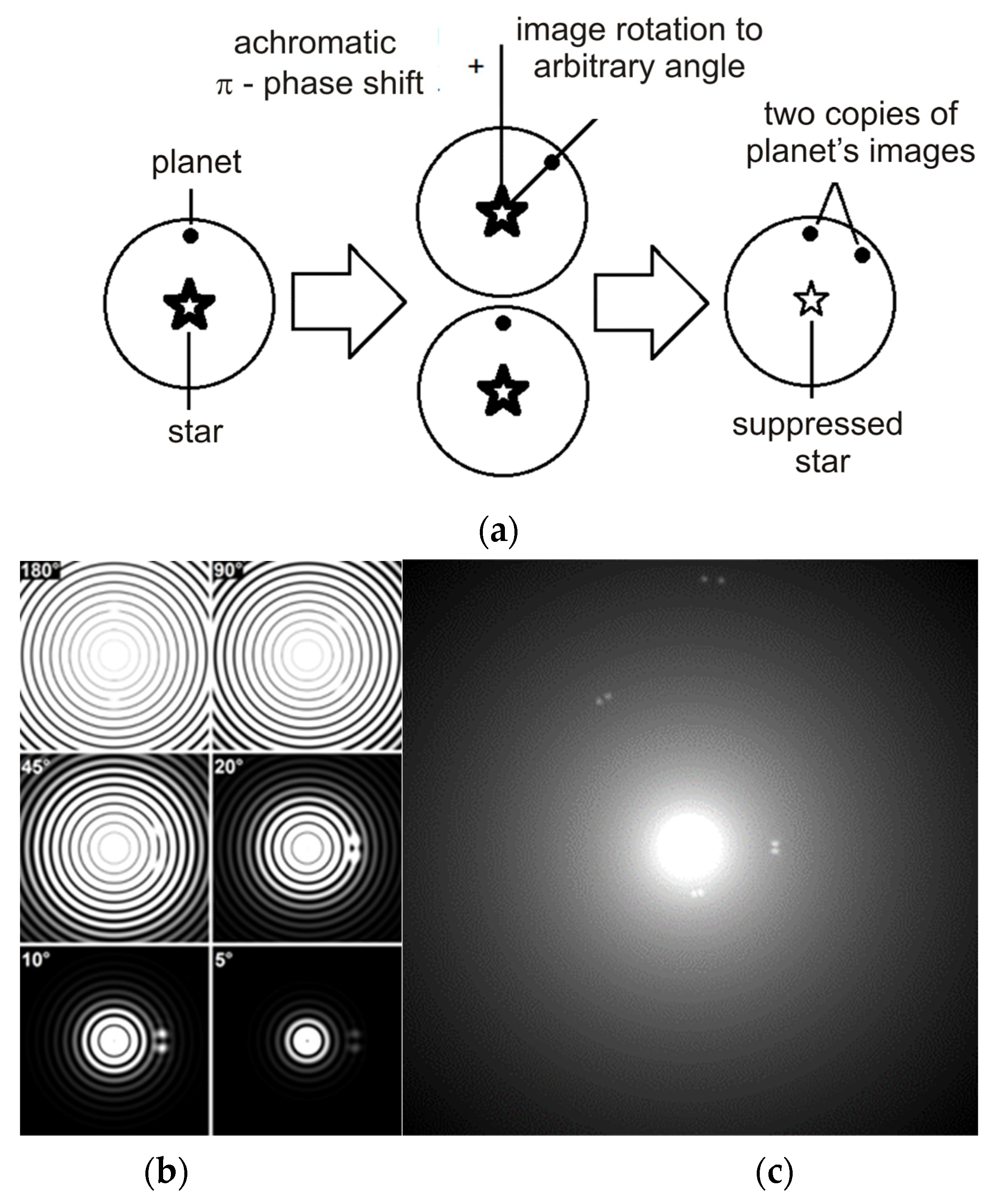

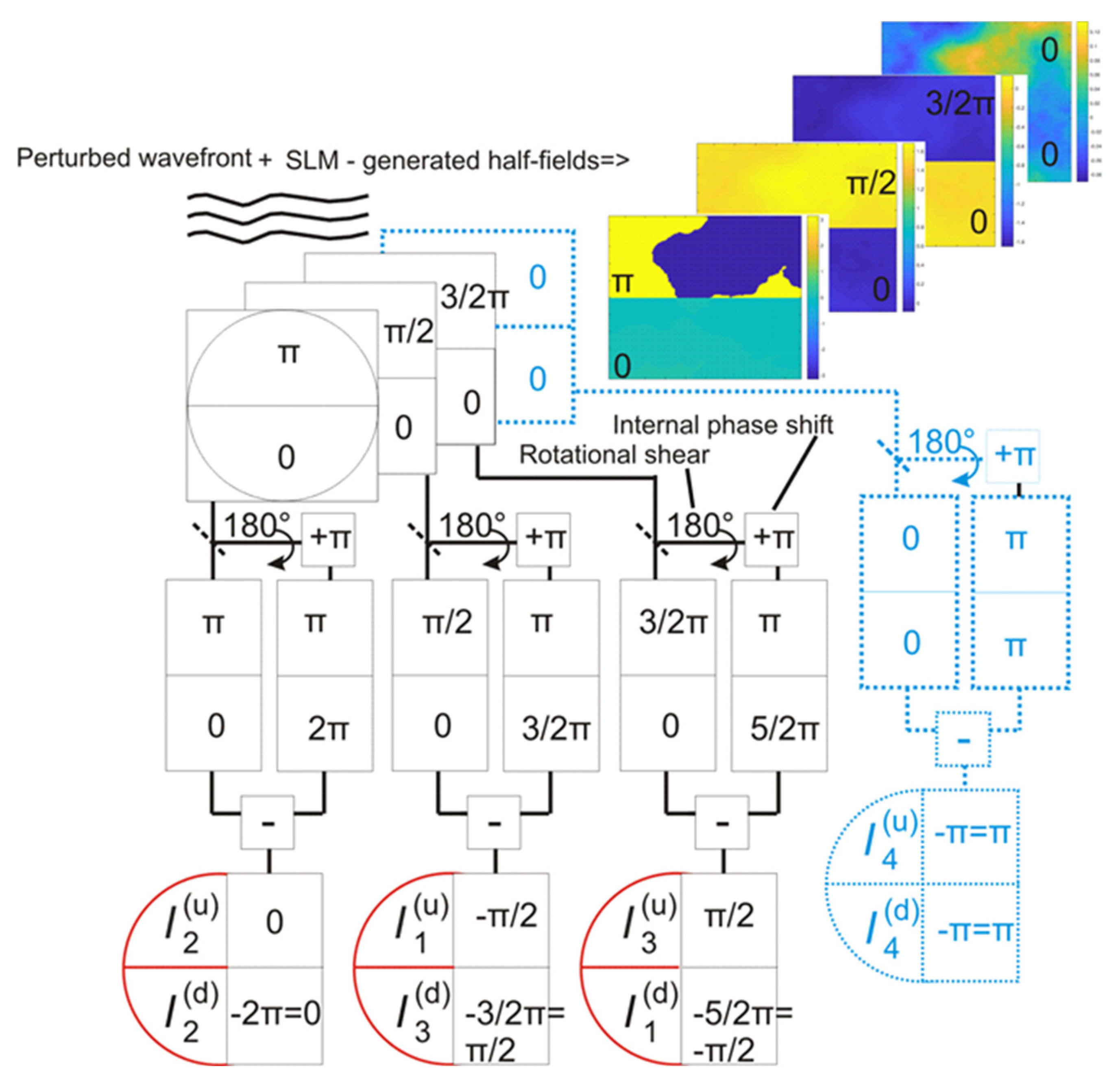

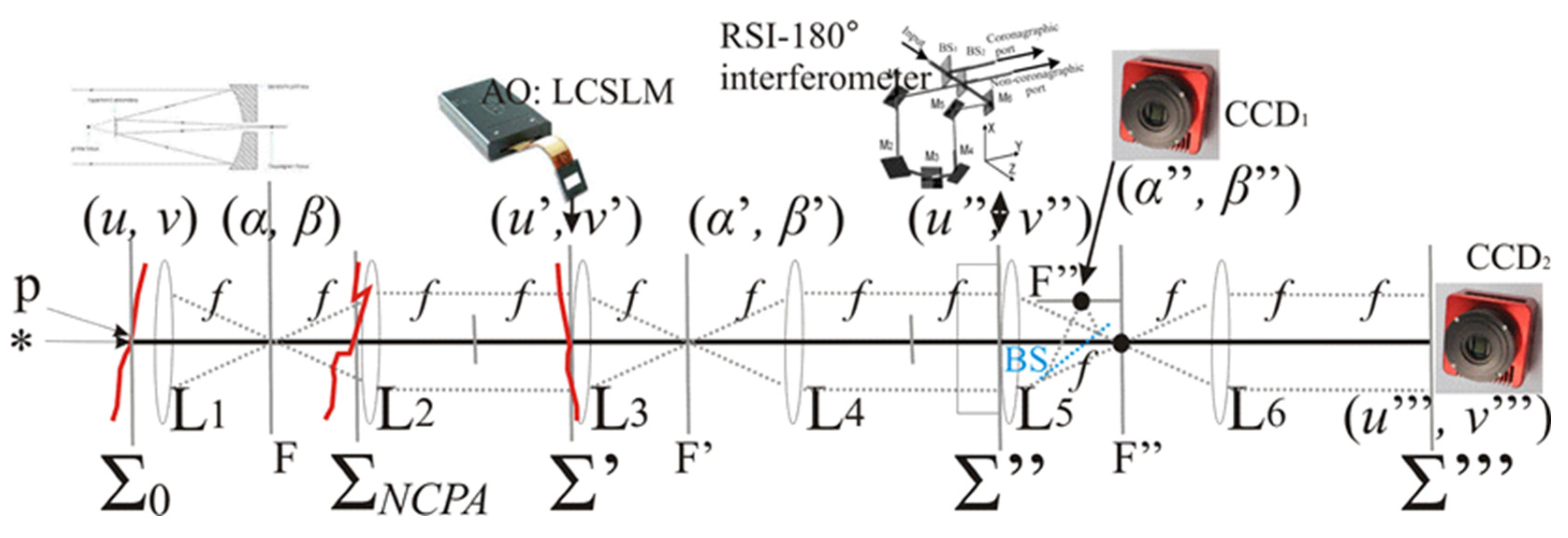
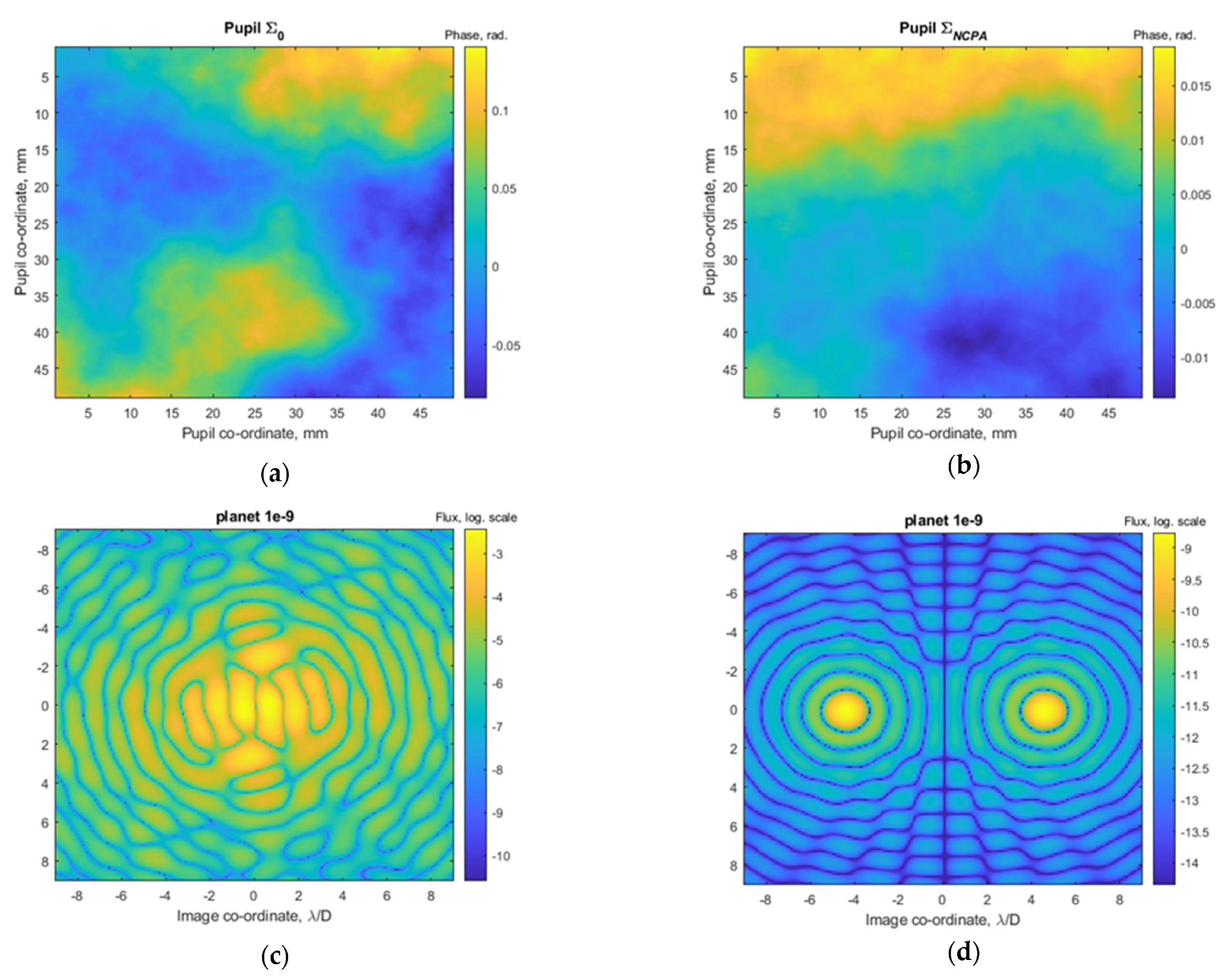

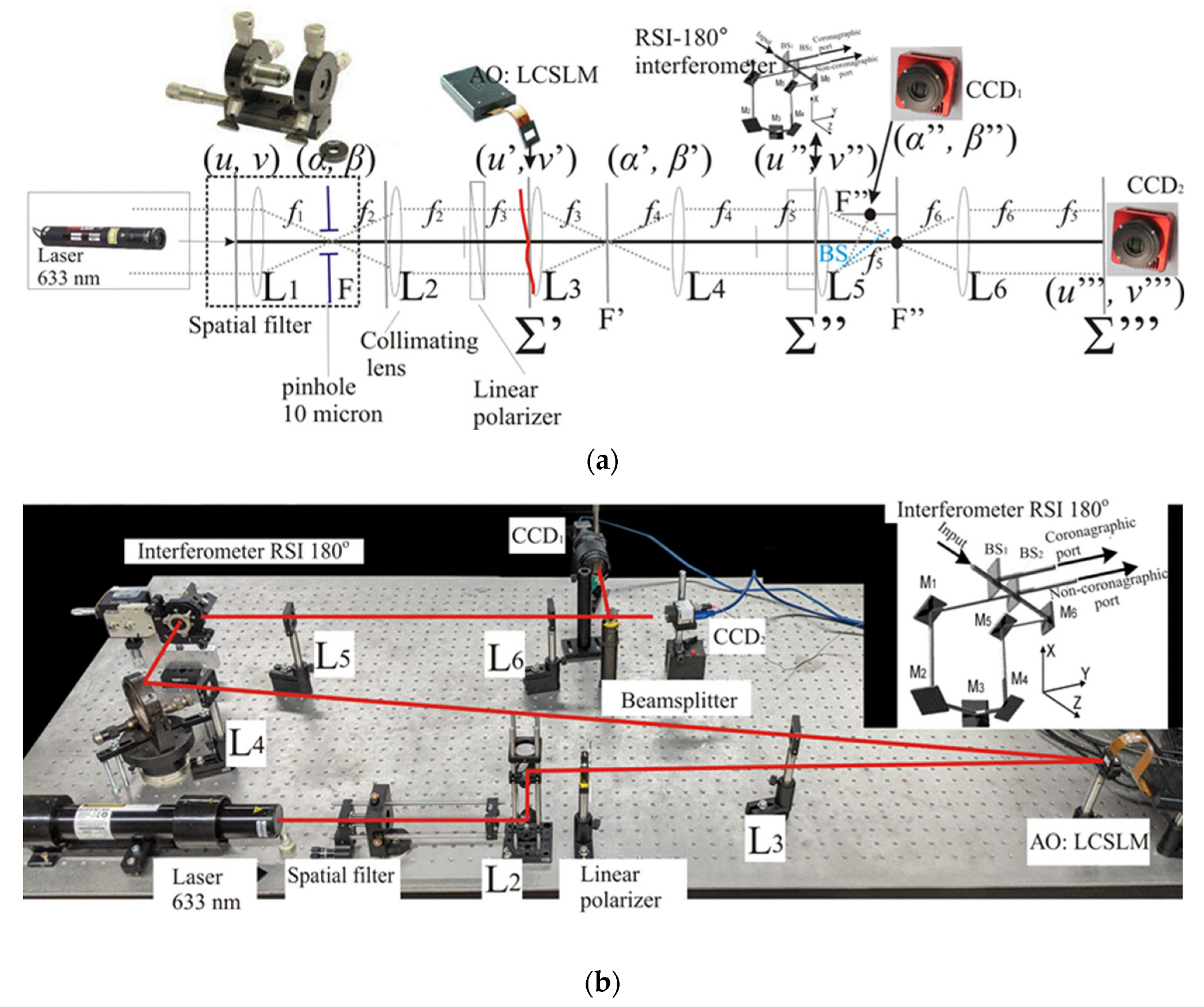

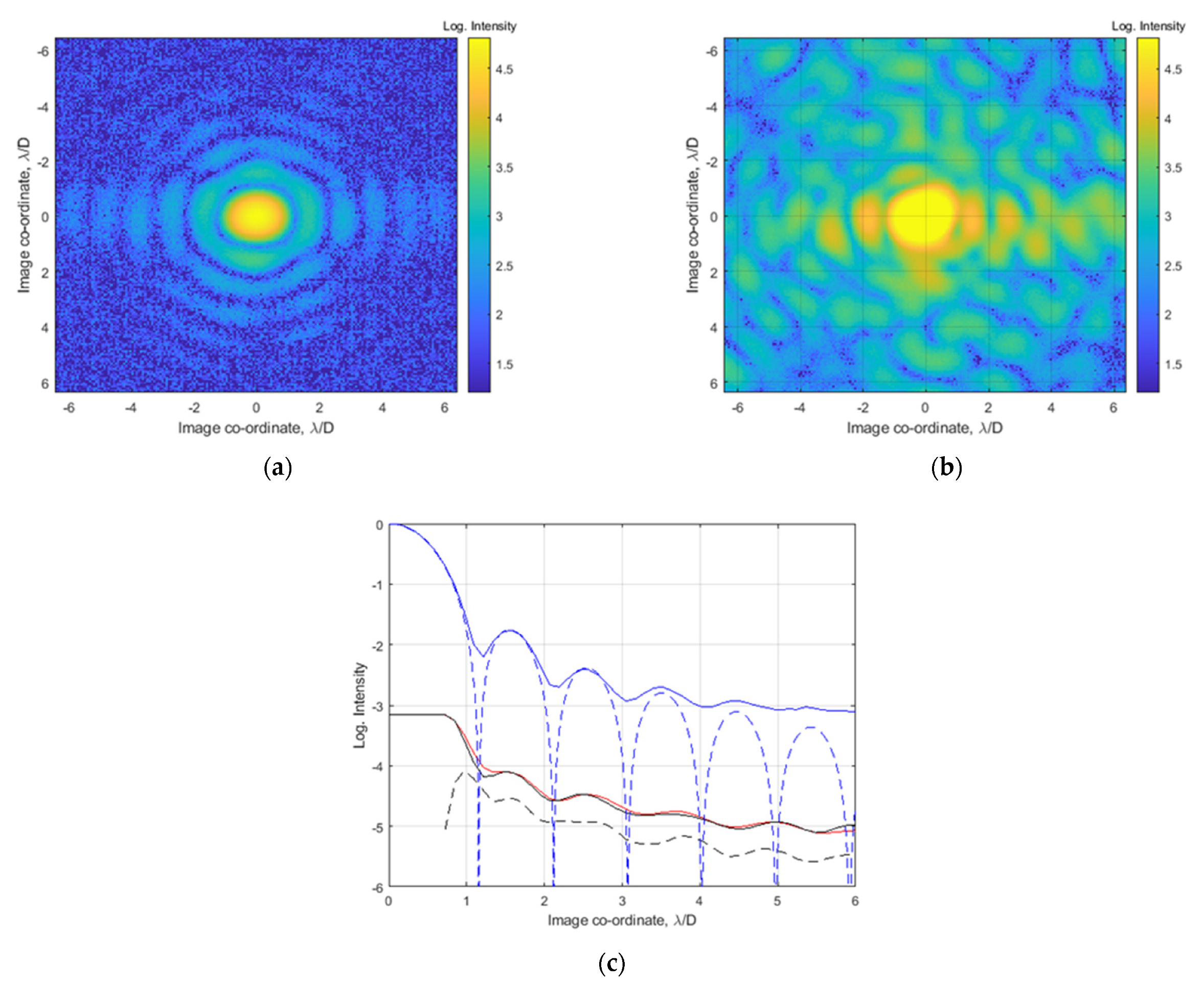
| PSI Technique | ||
|---|---|---|
| Three-step: = −π/2, 0, π/2 | ||
| Four-step: = −π/2, 0, π/2, π | ||
| N-step: = 0...2π/(N−1) |
Disclaimer/Publisher’s Note: The statements, opinions and data contained in all publications are solely those of the individual author(s) and contributor(s) and not of MDPI and/or the editor(s). MDPI and/or the editor(s) disclaim responsibility for any injury to people or property resulting from any ideas, methods, instructions or products referred to in the content. |
© 2023 by the authors. Licensee MDPI, Basel, Switzerland. This article is an open access article distributed under the terms and conditions of the Creative Commons Attribution (CC BY) license (https://creativecommons.org/licenses/by/4.0/).
Share and Cite
Yudaev, A.; Kiselev, A.; Shashkova, I.; Tavrov, A.; Lipatov, A.; Korablev, O. Wavefront Sensing by a Common-Path Interferometer for Wavefront Correction in Phase and Amplitude by a Liquid Crystal Spatial Light Modulator Aiming the Exoplanet Direct Imaging. Photonics 2023, 10, 320. https://doi.org/10.3390/photonics10030320
Yudaev A, Kiselev A, Shashkova I, Tavrov A, Lipatov A, Korablev O. Wavefront Sensing by a Common-Path Interferometer for Wavefront Correction in Phase and Amplitude by a Liquid Crystal Spatial Light Modulator Aiming the Exoplanet Direct Imaging. Photonics. 2023; 10(3):320. https://doi.org/10.3390/photonics10030320
Chicago/Turabian StyleYudaev, Andrey, Alexander Kiselev, Inna Shashkova, Alexander Tavrov, Alexander Lipatov, and Oleg Korablev. 2023. "Wavefront Sensing by a Common-Path Interferometer for Wavefront Correction in Phase and Amplitude by a Liquid Crystal Spatial Light Modulator Aiming the Exoplanet Direct Imaging" Photonics 10, no. 3: 320. https://doi.org/10.3390/photonics10030320
APA StyleYudaev, A., Kiselev, A., Shashkova, I., Tavrov, A., Lipatov, A., & Korablev, O. (2023). Wavefront Sensing by a Common-Path Interferometer for Wavefront Correction in Phase and Amplitude by a Liquid Crystal Spatial Light Modulator Aiming the Exoplanet Direct Imaging. Photonics, 10(3), 320. https://doi.org/10.3390/photonics10030320





